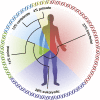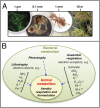Animals in a bacterial world, a new imperative for the life sciences
- PMID: 23391737
- PMCID: PMC3587249
- DOI: 10.1073/pnas.1218525110
Animals in a bacterial world, a new imperative for the life sciences
Abstract
In the last two decades, the widespread application of genetic and genomic approaches has revealed a bacterial world astonishing in its ubiquity and diversity. This review examines how a growing knowledge of the vast range of animal-bacterial interactions, whether in shared ecosystems or intimate symbioses, is fundamentally altering our understanding of animal biology. Specifically, we highlight recent technological and intellectual advances that have changed our thinking about five questions: how have bacteria facilitated the origin and evolution of animals; how do animals and bacteria affect each other's genomes; how does normal animal development depend on bacterial partners; how is homeostasis maintained between animals and their symbionts; and how can ecological approaches deepen our understanding of the multiple levels of animal-bacterial interaction. As answers to these fundamental questions emerge, all biologists will be challenged to broaden their appreciation of these interactions and to include investigations of the relationships between and among bacteria and their animal partners as we seek a better understanding of the natural world.
Conflict of interest statement
The authors declare no conflict of interest.
Figures




References
-
- Gilbert SF, Sapp J, Tauber AI. A symbiotic view of life: We have never been individuals. Q Rev Biol. 2012;87(4):335–341. - PubMed
-
- Knoll AH. Life on a Young Planet. Princeton, NJ: Princeton Univ Press; 2003.
Publication types
MeSH terms
Grants and funding
LinkOut - more resources
Full Text Sources
Other Literature Sources
Research Materials

